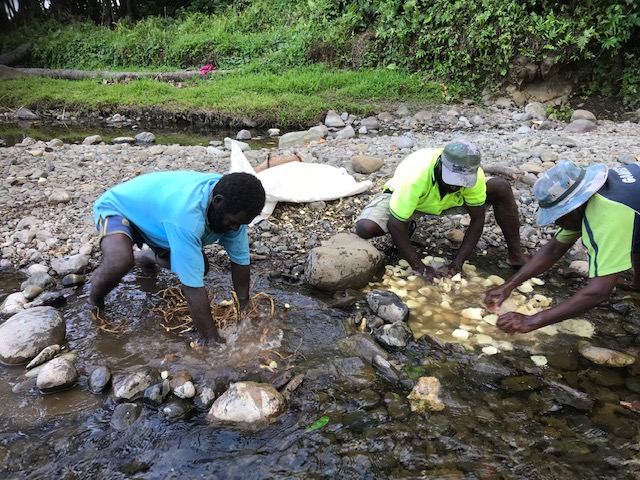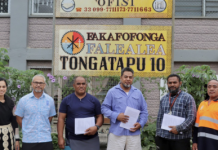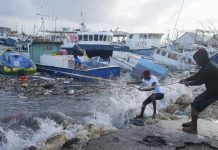A tonic made from the roots of a plant endemic to the Pacific region has long been mired by foreign misconceptions. Now it has a new potential threat.
Nestled in the lush and steep climes of Penecost Island in Vanuatu, Anthony Tapi and his neighbours grow taro, cassava, and island cabbage. His community of about 20 people, in the northern village of Amatbobo, sits down to cups of kava each night to relax after a hard day’s work.
A majority of Tapi’s 7.5 acres is dedicated to piper methysticum, a plant native to Vanuatu. When the plant’s roots and rhizomes are peeled, crushed, steeped in water and extracted, the final product is kava — other names around the Pacific Islands include ‘awa, sakau, yaqona or malok.
Priced for anxiety, stress and pain-relieving qualities, the plant is rolled out for big community events — deaths, marriages, and pig killing ceremonies among them. Though kava is important culturally, it has become a product he and his Ni-Vanuatu countrymen have used to improve their livelihoods, Tapi says.
Passing around shells of kava is a centuries old tradition among Pacific Island communities, but increased international interest has steadily bolstered demand over the past decade. Almost solely grown in Pacific Island nations, kava is being exported globally, although kava experts fear the industry could be taken outside the Pacific.
Traditionally grown by small-holdings farmers alongside subsistence crops, it is now taking over as a cash crop. Despite the 3,000-year-old cultivar becoming a more recent economic boon for the Pacific, industry insiders are expressing concern over murmurs of kava farming taking place in Australia.
Tapi both farms and acts as a broker for fellow Pentecost farmers, selling 1.4 tons of kava to exporters and dealers in Vanuatu’s capital Port Vila. Michael Louze, director of South Sea Commodities, purchases kava from around the country, including Tapi’s.
“Kava has been a real success story,” says Louze from his Port Vila office. “Before independence in 1980, the economy was based only on what I call colonial crops: copra, cocoa, coffee.”
Those colonial crops were at the whim of global production, as they competed with other areas and global prices. In the ’90s with the kava industry beginning to export a unique product unable to be produced in other places, things changed.
Because of its associated relaxing benefits, demand for kava increased. Pharmaceutical companies were interested, and Ni-Vanuatu farmers found themselves making good money. In 2019, kava constituted 57% of Vanuatu’s export market, worth approximately US$48.4 million.
“Travel around the kava producing islands. All the development you will see around you, the Land Cruisers, the solar panels in households, all the ports, and school fees for the kids,” says Louze. “All of this would have been paid for with kava money — 95%, no loan. Where in the world do you find farmers buying Land Cruisers with cash money?”
An International Market
Vanuatu published its Kava Act in 2002, which dictated that all production would be organic, of certain varieties, while protecting local growers and ensuring stringent quality standards for export; other countries have since started drafting similar legislation.
Louze’s network of farmers cultivate and harvest before drying their kava, which is shipped to Port Vila and cleaned and processed again. From Port Vila, Louze ships kava to New Caledonia and the United States. Others ship to Europe, New Zealand and Australia.
Heightened shipping costs have affected Louze — one of approximately 20 registered exporters in Port Vila — though this year he has still shipped five containers containing three to four tons of kava to the U.S. and New Caledonia. Vanuatu also exports kava to Fiji and Kiribati.
Tarcisius Kabutaulaka, director of the University of Hawaii’s Centre for Pacific Islands Studies, sees kava as a “huge” opportunity for Fiji and Vanuatu in particular. Both countries have vibrant internal markets and have already benefited from outside demand. In 2020, Fiji exported just short of US$20.7 million worth of kava, to the United States, New Zealand, Marshall Islands and Nauru. Crop production has almost doubled to just over 13,000 tons since 2016 as well.
Fijian-Australian company Fiji Kava Ltd., which produces powdered kava and various therapeutics made with kava, listed on the Australian Stock Exchange in 2018. Its founder Zane Yoshida saw kava as a form of relief for the stressed masses, highlighted by the Covid-19 pandemic, and estimated the kava industry would be worth US$210 billion by 2026 — including therapeutic adaptations, aside from the beverage.
While kava bars around the U.S have closed, Fiji Kava’s growth increased 33% in the country, he says. Last year, the company signed a deal with a distributor in China, where the vitamin and supplement market is worth US$29 billion.
Fiji Kava now employs 40 people in Fiji and Australia, who work in the company’s tissue lab, its nucleus farm and in its offices, while it also has direct relationships with farmers around the country. Kabutaulaka says the increased interest — and volume cultivated, processed and exported — is already benefiting Pacific Islanders directly.
“Kava, because of the nature of the industry, because it’s produced in villages, the money directly goes to the village level,” he says.
Not a traditional consumer of kava, Kabutaulaka’s native Solomon Islands has also started growing the product for export. But Kabtaulaka is most concerned about kava being produced outside the Pacific.
Bundaberg Regional Council, in Australia’s Queensland, registered its interest in growing the plant with the country’s Department of Foreign Affairs and Trade, despite long-held restrictions on the product. If successful, production in Australia could have potentially devastating effects for the Pacific Island industry.
“Apart from the issues of incomes, it’s an issue of appropriation,” says Kabutaulaka.
Louze has worked with farmers such as Tapi in Vanuatu for more than 20 years, working with his own business for almost 12, and he finds the idea of Australian-grown kava insulting.
The country lists kava among its controlled substances, and has long had strict restrictions on its import. In 2019 Australian prime minister Scott Morrison announced that kava import rules would be eased by the end of 2020, though plans were delayed by the pandemic.
Given the country’s potential capacity for producing kava, Louze is alarmed.
“We will never, ever, ever, ever, be able to compete on any agricultural products,” he says. “We only have one product … which has high value for farmers.”
Yoshida suggested Australia divert its interest to further developing its kava-based programs throughout the Pacific, to help the countries where it could potentially make a difference.
“There certainly is that kind of support (already). They should be looking to ramp up,” says Yoshida, especially in light of potential legislative changes in Australia, and the potential domestic market there.
Now that kava has become more acceptable outside of the Pacific, used in specialty bars and lounges across the United States, Australia, New Zealand and Europe, concern over foreign kava crops has become a key question.
Dr Vincent Lebot, author of “Kava: The Pacific Elixir,” says Vanuatu’s Kava Act aims to promote kava in the same way Italy and France might promote their unique food products.
“Just like Scottish whisky, Darjeeling tea, Blue Mountain coffee from Jamaica, or Korean ginseng … we want to develop kava as something unique to the South Pacific, based on traditional knowledge,” says Lebot. “The problem is that we don’t have a product yet.”
To get such a product, consistency and quality is needed, he says, as well as a degree of standardization, which has not yet been achieved across the Pacific. It is far from impossible to achieve, he says, though it needs to be properly marketed too.
A Maligned Elixir
There are 120 different varieties of kava, which all share kavalactone compounds that give the plant its sedative quality. Kava took prominence in societal gatherings before colonization of the Pacific; it was offered to dignitaries, used to facilitate talanoa or constructive conversation, and the different varieties became known for their unique effects.
Pacific Island communities consume the tonic in different ways, to achieve different means. In Vanuatu, for instance, kava is generally a stronger post-conversation drink; in Fiji or Tonga, it is weaker and consumed four hours while people converse.
Lebot says that before colonization kava was the only way they could access “artificial paradise.”
The Frenchman moved to Vanuatu in 1981 as a young researcher, and became fascinated by the plant and the “licoricey” product prized by Ni-Vanuatu people. It was “under-researched and poorly documented” so he researched kava in the Pacific for his Ph.D, and began supposing direct connections between the islands.
“When you follow kava, you follow people. It has such a high cultural importance that people most likely couldn’t imagine settling somewhere without it,” says Lebot. “It was very important for kings and chiefs, and for running, I would say, society in general.”
When he started his research, collecting 300 samples from 35 Pacific islands, he found punitive colonial rule had almost destroyed traditional kava culture in some places, although he managed to find surviving plants deep in gulches and along creeks in places like Hawaii (which were strikingly similar to a variety found in The Marquesas Islands). Kava brought people together to discuss personal and community issues in their mother tongue.
“In other words, it was a threat to colonial power,” says Lebot.
More than colonialism, misconceptions about the effects of kava have long plagued its international success. German pharmaceutical companies attempted to isolate kavalactones for medicinal purposes in the late 1990s, prompting a spike in demand, but found the result unfit and dangerous. This led to Germany banning all kava in 2002, and other European nations following suit.
Lebot says kavalactones are not kava just as caffeine is not coffee. Germany’s ban was lifted in 2014, when a court decision deemed previous evidence insufficient. In 2020, the Food and Agriculture Organization and World Health Organization officially recognized kava as part of the Codex Alimentarius, essentially recognizing kava as food and publishing a best practice guide to kava production.
Kava has come to be used in cancer research, associated with relief for anxiety disorders, and has been considered a healthier alternative to alcohol. It is now being grown on islands where it had once virtually disappeared, including some varieties in Hawaii.
In Hawaii, the nonprofit Awa Development Council was started in 2005 to advocate for kava and its place in culture.
Jonathan Yee, a member of the council’s board of directors, says current demand outweighs supply in Hawaii. The associated costs of growing awa in Hawaii — utilities, labor, taxes — made it a more premium product, so value-added products were the best way to do business.
Yee says the product is particularly popular with those who value Hawaiian culture and young people, and there is a smattering of awa or kava bars across the islands.
Pu’u O Hoku Farm and Ranch is one of the largest awa producers in the state, on the eastern edge of Molokai. With 25 acres of awa, planted with native banana varieties, the ranch is likely the state’s only producer of frozen awa pulp. It supplies customers across the mainland, but its main market is in Hawaii.
Manager Rudy Hunke says demand is increasing, which he thinks could be partly due to cheaper powdered products from places like Vanuatu becoming harder to come by. The ranch is expanding its awa production in response, but he does not believe the ranch’s success should be measured in exports, sales or profits.
“Our main customers are Hawaiian native people. The feedback that we get from our customers is what motivates us,” Hunke says. “It’s not important how many bars there are, it’s important how heady we make our customers.”
The Kava Lounge
In New Zealand, in the urban center of Auckland, Four Shells Kava Lounge’s menu is almost exclusively kava. They are described as “fast acting,” “heady,” “uplifting,” or “deeply relaxing,” and the products hail from Tonga, Fiji and most commonly, Vanuatu. It is one of about seven outlets serving kava in the country.
Owners Anau and Todd Henry used Ni-Vanuatu kava first thanks to the quality assurance provided by the Kava Act, and later began offering Fijian and Tongan products once reliable sources were found.
Unlike many bars across the United States where kava is served in mixed cocktail-like drinks, the couple strictly serve kava traditionally, disassociating kava from alcohol and bar culture. In addition to hosting the Vanuatu, Fijian and Tongan diaspora, the couple spend a lot of time telling people how kava works, according to Todd Henry.
Each kava has provenance, Todd Henry says, as different cultivars give differing psychological effects.
“I find the best way to tell people about it is that we consider it the opposite to coffee … at the end of the day, we drink kava to unwind,” he says.
For the kava export industry to grow, quality needs to be assured. Todd Henry believes it’s inevitable kava will be grown outside the Pacific, though he does not want that to happen. He wants the island nations to reap the benefits of their culture and the cultivar, which one of his Ni-Vanuatu patrons calls the nation’s “diamond.”
“I almost feel like it’s a gift from their ancestors,” he says.
Thomas Heaton is a Li Center for Global Journalism Fellow. The position is supported by the Columbia University Graduate School of Journalism and the Institute for Nonprofit News. You can reach him by email at theaton@civilbeat.org or follow him on Twitter at @thomasheaton.
SOURCE: HONOLULU CIVIL BEAT/PACNEWS















